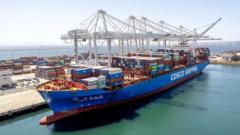In a surprising regulatory shift, President Trump's recent decision to terminate the de minimis exemption for packages from China and Hong Kong could impact the fast-fashion sector. This modification is designed to close a loophole that previously allowed goods valued under $800 to enter the U.S. free of tariffs, contributing to a significant volume of airborne commerce.
Tariff Changes Could Unintentionally Reduce Emissions from Fast Fashion

Tariff Changes Could Unintentionally Reduce Emissions from Fast Fashion
New tariffs on Chinese goods may shift how the fashion industry operates and impact emissions from e-commerce shipping.
Last year alone, over 1.36 billion packages entered the U.S. without tariffs, marking a considerable increase in carbon emissions from the fashion industry. Incoming goods, primarily shipped by air, have been linked to greenhouse gases; shipping a single package via plane is reported to be about 68 times more environmentally harmful than using ocean freight.
In many parts of the world, including Europe and Argentina, lower de minimis thresholds exist, facilitating the trade of small packages. However, the ongoing U.S. policy has favored foreign e-commerce platforms, enabling them to provide cheaper products and compete vigorously with local giants like Amazon and Walmart.
As the implications of tariff changes unfold, the potential increase in shipping costs could not only alter consumer purchasing behavior but also lead to a decrease in emissions associated with fast-fashion logistics. The broader effects of this policy change remain to be seen, as both businesses and consumers adjust to the new reality.
In many parts of the world, including Europe and Argentina, lower de minimis thresholds exist, facilitating the trade of small packages. However, the ongoing U.S. policy has favored foreign e-commerce platforms, enabling them to provide cheaper products and compete vigorously with local giants like Amazon and Walmart.
As the implications of tariff changes unfold, the potential increase in shipping costs could not only alter consumer purchasing behavior but also lead to a decrease in emissions associated with fast-fashion logistics. The broader effects of this policy change remain to be seen, as both businesses and consumers adjust to the new reality.






















